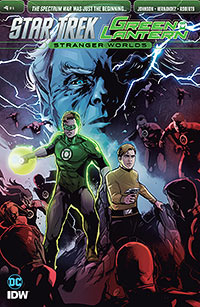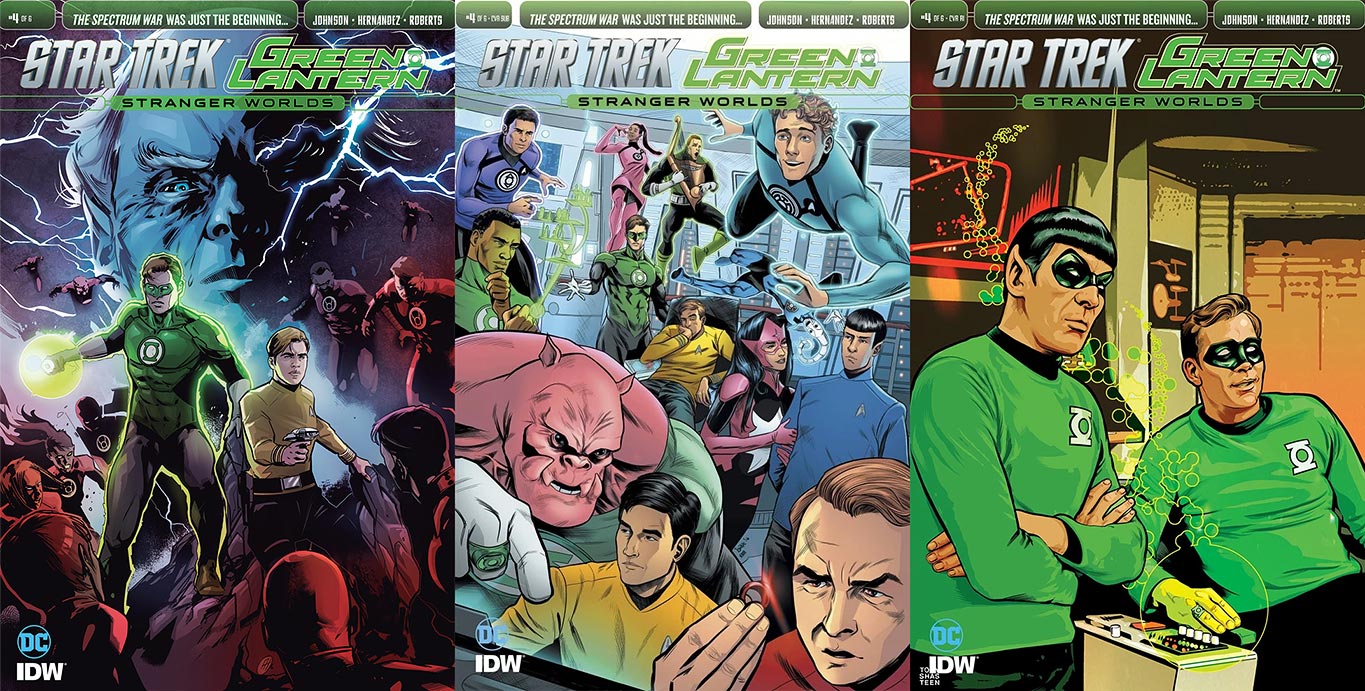The tricky thing with a mini-series is that the writer has to create the illusion of futility in a story.
There’s a very delicate balance in maintaining the sense that the protagonist has absolutely no chance of overcoming the odds, and the reader will have no idea of the outcome by the time the six issue arc is done.
That’s a skillful act of writing and given that you take two seemingly mismatched franchises like DC’s Green Lantern and Star Trek, and manage to create not only a workable story but also one that keeps the reader on edge.
I’ve made no secret of how much I admire Mike Johnson’s writing, but I have to say that I’ve gained a new appreciation for it in reading this fourth issue of Star Trek/Green Lantern: Stranger Worlds.
Just to provide a bit of context behind this, imagine the greatest Trek villain — namely Khan Noonien Singh — ramped up with the addition of a device fueled by sheer unadulterated rage. Even Benedict Cumberbatch’s version of Khan, which seemed more fueled by contempt than the Ricardo Montalban presentation, is amplified by Johnson’s addition of Attrocitus’s red ring of rage to Khan’s arsenal.
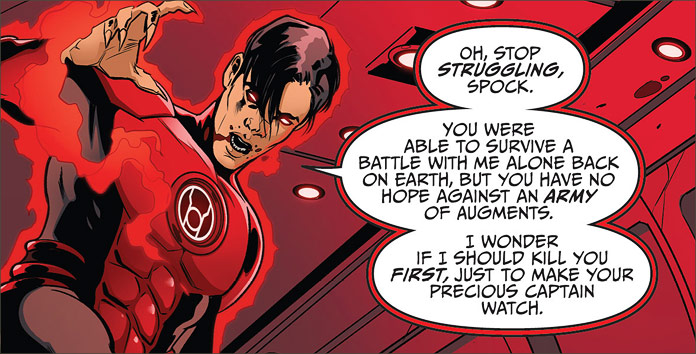
That’s where we left the story last issue and given that all the ringbearers, regardless of colour, are almost out of charge, and the Federation has Sinestro in charge of the Klingon Empire on top of Khan’s new powers and freed Augment army.
Oh… and Sinestro has found Oa first; but it’s a primitive Oa in which the Guardians are fairly naïve and haven’t developed the need to maintain order in the universe. You know: vulnerable.
Those would be the overwhelming odds I was referring to just now. If you want to get completely fanboy, don’t you think that even the combined ingenuity of Captain Kirk and Commander Spock would be hard-pressed to combat the Klingon Empire and the negative portion of the spectrum of willpower? Mike Johnson thinks so, and that’s the secret of his success with this title – at least from what I’ve been able to discern. He is able to extrapolate the two fandoms and find where they intersect and make this book work.
Let’s review: Sinestro represents fear, which Johnson interprets as the motivating control behind the Klingon Empire. (Although, while I must observe, I disagreed with this relationship when I reviewed the first issue of this series, it was heartening to see that in this this issue, Larfleeze actually agreed with me and mentioned that he felt they were also motivated by rage.)
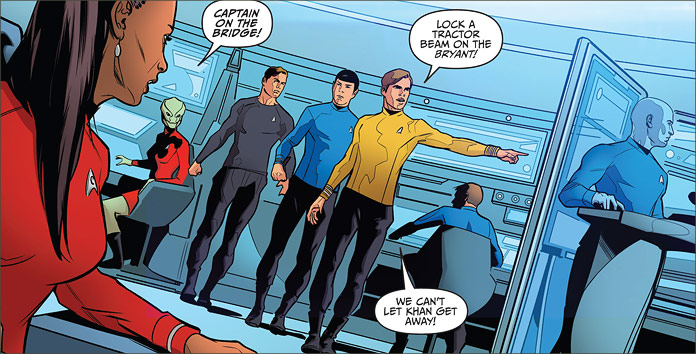
Given that we really don’t know very much about the Klingons in the Kelvin Timeline, it’s completely plausible that perhaps their culture is one that is based on fear and this additional potential extrapolation is also a reason why I am digging this story so much. Still, fear and the Klingons represent that fandom intersection that Johnson does so well.
The reader is so beguiled by how well Johnson makes the characters work that she doesn’t waste time in trying to figure out how Johnson does it; well, unless you’re a Trek-lovin’, comic-readin’ geek like me. There’s a simple fluidity in the storytelling that probably explains why IDW decided to make a second run at this title. Clearly, it’s a winning concept and Johnson’s writing is certainly behind it.
But it’s impossible to leave Angel Hernandez’s art out of the equation. There’s a very apparent dynamism to his art that is responsible for the hectic pace in which this story occurs. If Hernandez does anything well, it’s action. The combat sequences between Kirk, Jordan and company versus the Augments and Khan is definitely a high point in this issue.
Yeah – I liked the fighting; particularly the order for Kirk to set phasers on kill. That’s a statement you’d never really associate with Captain Kirk, but it really illustrates how dangerous a threat Khan is if Kirk is willing to give that order.
- As usual, IDW gives us a variety of covers for us to appreciate. The first is the regular retail cover, by Angel Hernandez, and is a fully dramatic one that covers the full range of themes contained in the storyline in this book. It’s a generic one in terms of story details, but it’s a damn fine selection.
- The second cover is the subscription cover by Isaac Goodheart, and it’s a little more fanciful. It’s very solid and definitely a concrete piece of work that I can appreciate. It’s got a lot of humour and while it may run independently of the storyline, it’s certainly an entertaining piece of art that Goodheart was clearly having fun with as he created it. It’s pretty cute and is a lot of fun.
- The last cover – the retailer incentive cover – is by Tony Shasteen and is a definite throwback to the sixties. When you see Shasteen’s renditions of the traditional versions of William Shatner and Leonard Nimoy as Captain Kirk and Mr. Spock, you might think they are out of place for a Kelvin Timeline story.
For me, though, it’s not only appropriate, in terms of reminding readers of Trek roots, but the Green Lantern domino masks and uniforms have a Green Hornet vibe to them that places them within original 1960’s television roots. This is probably the most striking and insightful cover and is definitely my favourite amongst the three.
I was speaking with J.K. Woodward about Shasteen’s talent recently: “I love his work,” Woodward told me, “that guy makes it look easy.” High praise from a talented colleague.
I honestly don’t know how Johnson is going to write the allied forces of Kirk, crew and the Lanterns out of this dilemma, because in my opinion, it looks like they’ve met their match. But if I can’t foresee how he’s going to accomplish this, then it’s a pretty sure thing that other folks might also share this inability.
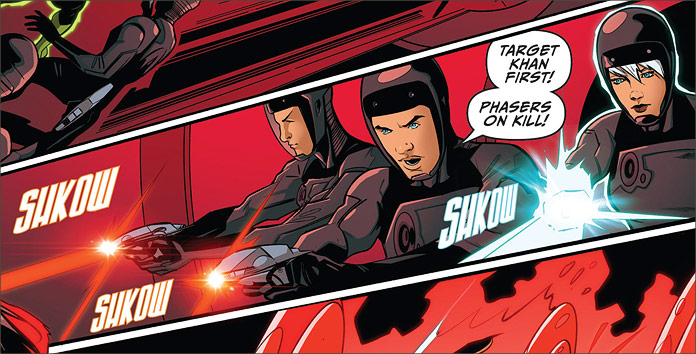
But, isn’t that what Johnson is trying to do? Then, that’s why this series works so well and is definitely something that you should take a look at. Try to ignore the futility as you read this book… just relax and go with it.
Trust me.

